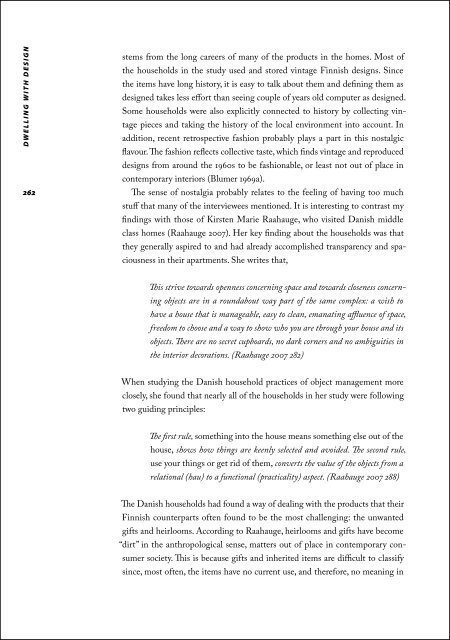Lataa ilmaiseksi
Lataa ilmaiseksi
Lataa ilmaiseksi
Create successful ePaper yourself
Turn your PDF publications into a flip-book with our unique Google optimized e-Paper software.
D W E L L I N G W I T H D E S I G N<br />
262<br />
stems from the long careers of many of the products in the homes. Most of<br />
the households in the study used and stored vintage Finnish designs. Since<br />
the items have long history, it is easy to talk about them and defining them as<br />
designed takes less effort than seeing couple of years old computer as designed.<br />
Some households were also explicitly connected to history by collecting vintage<br />
pieces and taking the history of the local environment into account. In<br />
addition, recent retrospective fashion probably plays a part in this nostalgic<br />
flavour. The fashion reflects collective taste, which finds vintage and reproduced<br />
designs from around the 1960s to be fashionable, or least not out of place in<br />
contemporary interiors (Blumer 1969a).<br />
The sense of nostalgia probably relates to the feeling of having too much<br />
stuff that many of the interviewees mentioned. It is interesting to contrast my<br />
findings with those of Kirsten Marie Raahauge, who visited Danish middle<br />
class homes (Raahauge 2007). Her key finding about the households was that<br />
they generally aspired to and had already accomplished transparency and spaciousness<br />
in their apartments. She writes that,<br />
This strive towards openness concerning space and towards closeness concerning<br />
objects are in a roundabout way part of the same complex: a wish to<br />
have a house that is manageable, easy to clean, emanating affluence of space,<br />
freedom to choose and a way to show who you are through your house and its<br />
objects. There are no secret cupboards, no dark corners and no ambiguities in<br />
the interior decorations. (Raahauge 2007 282)<br />
When studying the Danish household practices of object management more<br />
closely, she found that nearly all of the households in her study were following<br />
two guiding principles:<br />
The first rule, something into the house means something else out of the<br />
house, shows how things are keenly selected and avoided. The second rule,<br />
use your things or get rid of them, converts the value of the objects from a<br />
relational (hau) to a functional (practicality) aspect. (Raahauge 2007 288)<br />
The Danish households had found a way of dealing with the products that their<br />
Finnish counterparts often found to be the most challenging: the unwanted<br />
gifts and heirlooms. According to Raahauge, heirlooms and gifts have become<br />
“dirt” in the anthropological sense, matters out of place in contemporary consumer<br />
society. This is because gifts and inherited items are difficult to classify<br />
since, most often, the items have no current use, and therefore, no meaning in
















